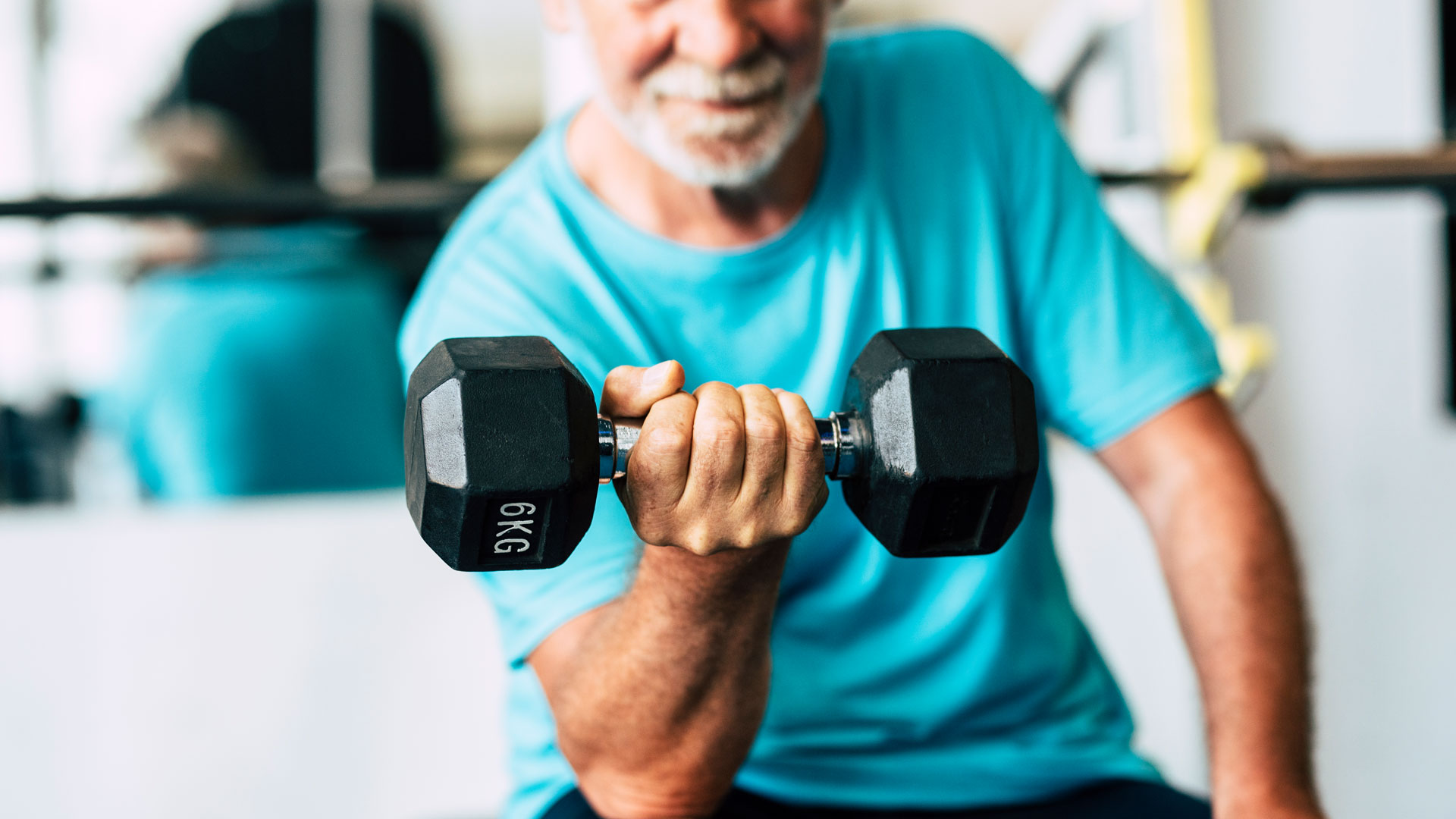
What is the fastest way to build muscle? Well, we have all the know-how to inform your future workouts. While you might be tempted to lift heavier weights more frequently to get what you want, it turns out there’s a more complicated road to reaching your fitness goals.
In order to understand how to improve your strength, it’s essential to understand the process of muscle building in the first place. When you do strength training, you’re using resistance in order to challenge your muscles, forcing them to work harder than they would usually. This can be done in the gym or at home, by investing in equipment like the best adjustable dumbbells. The journal of Critical Reviews in Food Science and Nutrition explains that this process kickstarts your body to create new fibers and extend existing ones in order to repair the damage, and therefore increases your strength.
If you’re not inclined to lift weights, then you can also increase strength using equipment like the best resistance bands, and use your body weight as the force, which causes tiny tears in your muscle fibers which your body then works to repair.
Find the fastest way to build muscle below.

How long does it take to build muscle?
Effectively building muscle is a slow process, but when completing strength workouts consistently and correctly, you should begin to see results in three-four weeks, with larger changes to physique taking several months to be noticeable.
To achieve these results, research shows that you need to be working out each muscle group two-three times a week, carrying out four-eight sets of eight-twelve repetitions (reps) on each group depending on your level of experience with strength training.
If you are new to strength training, the number of sets required to build muscle will be lower than it is for an experienced weightlifter, and as your muscle mass increases, so too should the number of sets you complete.
Start your week with achievable workout ideas, health tips and wellbeing advice in your inbox.
We asked Dr Brian Carson, co-founder of Whole Supp and a lecturer in the department of Physical Education and Sport Sciences at the University of Limerick, explains what the fastest way to build muscle is and he said: “As new research evidence mounts, it appears there is more than one way to build muscle. Traditionally, those seeking to increase their muscle mass would follow a hypertrophy program involving training of all major muscle groups on 2-4 times per week with sessions consisting of 3–4 sets of 8–12 reps, with 2–5 min rest between sets, with up to as many as 10 exercises," he says. "These methods have proven to be successful in the development of muscle and strength over time.”

Dr. Brian Carson graduated with a first-class honors BSc. in Sports Science and Health from the School of Health and Human Performance at Dublin City University in 2005. Brian subsequently undertook a PhD funded by a scholarship from the Irish Research Council for Science, Engineering and Technology (IRCSET) entitled “The regulation of metabolic gene expression in human skeletal muscle by exercise: the influence of exercise intensity and contraction frequency” which was awarded in 2010. He then was appointed as a postdoctoral researcher funded by Diabetes UK at the Department of Cellular and Molecular Physiology at the University of Liverpool where he spent 18 months investigating the intracellular trafficking and release of the adipokine adipokines. From there, Brian joined the team in the Physical Education and Sport Sciences department at the University of Limerick as a lecturer in Exercise Physiology in January 2011 where he is pursuing research into the role of exercise and nutrition in the regulation of metabolism for performance and health.
What is the fastest way to build muscle safely?
As your strength increases, you will need to increase the amount of resistance you use to get the most out of your workout; this is called progressive overload. The easiest way to do this is by gradually increasing the weight you are lifting, or if you’re not quite ready for a heavier weight, adding to the number of reps for each exercise.
You can also reduce rest time between sets and increase volume by training more often, but these methods of overloading are more about improving endurance than building muscle. Progressive overload is one of the fastest ways to build muscle because it ensures constant growth and development as you continue to challenge your body.
‘Lifting to failure’ is also a good way to know that you are getting the most out of your strength workout. This doesn’t mean lifting the heaviest you can, but choosing an appropriate weight for your ability and then completing your workout to the point where you should be failing your final set one-four reps before the end.
Research shows you do not need to complete these last reps and if you are aware that you are approaching failure, stopping two - three reps before failure will actually have the same muscle-building results as lifting to complete failure. This ensures that the short-twitch muscle fibers are appropriately fatigued in order to trigger muscle growth.
If you are lifting to failure it is important that you have someone with you to ‘spot’ when you might need assistance to get out of an exercise, particularly when using barbells or squatting racks, as you can get trapped beneath the weight.

According to research, your diet is also incredibly important when trying to build muscle, as your body needs to repair the damage inflicted on the muscles with strength exercise. Protein is the primary macronutrient that your body uses for growth and repair, and is found in sources such as lean meat and fish, or nuts and legumes if you are on a plant-based diet.
In general, adults are recommended to consume 0.8 grams of protein for every kilogram of body weight, and this requirement increases in correlation with increased lean muscle mass, with athletes encouraged to eat 1.2g-2.0g of protein per kilogram of body weight. It is also important to eat protein throughout the day, as research indicates that protein turnover (the process your body goes through to build lean muscle mass) increases when you undertake regular strength training, so you need to be replenishing frequently.
Ensuring that you include a source of protein in every meal, and have protein-rich snacks throughout the day will help you stay on top of your body’s protein turnover and ensure that you are eating enough to support your body as you build muscle. Carson advised: “Post exercise meals should generally be high in protein. This promotes muscle protein synthesis to help our muscle recover and adapt following exercise. This is especially important after resistance exercise training. We have demonstrated previously that 0.33 grams per kilogram of your body mass is an excellent dose of protein to promote muscle protein synthesis after an exercise session”
Carson told Fit&Well: “The quality of that protein is also important, in that it should contain a high proportion of essential amino acids as these are most important for promoting muscle growth and repair. ”
What are common muscle-building misconceptions?
You may be tempted to lift the heaviest weight you can manage, because you believe that the fastest way to build muscle is to lift heavier, but this can be dangerous. When we lift at a weight beyond our capabilities it is often at the detriment of our lifting form, which can cause injuries. If you are relying on momentum to lift a weight, then you are unlikely to be correctly working the muscle group that you are trying to target, and will be compensating with other muscles to complete the exercise. It is important not to ‘ego-lift’ and to properly assess your abilities, choose the appropriate weight, and complete the exercise in a slow and controlled manner.
If you’re thinking about investing in your own weights, don’t miss our round up of dumbbells on sale.

Lou Mudge is a Health Writer at Future Plc, working across Fit&Well and Coach. She previously worked for Live Science, and regularly writes for Space.com and Pet's Radar. Based in Bath, UK, she has a passion for food, nutrition and health and is eager to demystify diet culture in order to make health and fitness accessible to everybody.
Multiple diagnoses in her early twenties sparked an interest in the gut-brain axis and the impact that diet and exercise can have on both physical and mental health. She was put on the FODMAP elimination diet during this time and learned to adapt recipes to fit these parameters, while retaining core flavors and textures, and now enjoys cooking for gut health.
